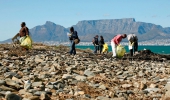Words: Aim Marketing & Communications Consultants
Johannesburg, 25 May 2015. The latest plastic recycling figures released by Plastics|SA are reflective of a vibrant and dynamic industry that is growing despite the many challenges it faces.
“The South African plastics industry is currently in the throes of one of the most challenging periods in its history. Not only are we facing increased electricity, transport and raw material costs on the local front, but the sharp increase in imports also poses a very real threat to our progress. Despite this, the industry has shown encouraging signs of growth both in terms of the amount of plastics that are diverted from landfill and job creation,” says Anton Hanekom, Executive Director of Plastics|SA.
Each year, an in-depth survey into the state of plastics recycling in South Africa is conducted on behalf of Plastics|SA, the mouthpiece of the local plastics industry, by plastics recycling guru Annabe Pretorius of Plastix 911. “The information we obtain for our survey is received from one-on-one interviews held with recyclers around the country, and provides valuable data to our members, government and the wider community with regards to the state of plastics recycling industry, imports, local processing and exports for reprocessing,” Hanekom explains.
“It gives us a clear indication of the flow of plastics products in South Africa, the state of the plastics recycling industry and the recyclate markets and is therefore a valuable tool for promotion, knowledge of the industry and forward planning, policy development and assisting in setting targets for end-of-life solutions”.
Plastic conversion rates stagnate
The 2014 results just released have shown that a total of 1 400 000 tons of plastics from domestic production and imported materials were converted in South Africa in 2014. Hanekom says that “although this is the same total as was reported for 2013, the conversion rates for certain types of plastics have increased and others decreased in tonnages owing to the impact of light-weighting plastics packaging, which had a marked increase on South Africa’s consumption rate.
Increase in amount of plastic diverted from landfill
Earlier last year, the South African plastics industry had set itself the aspirational target of diverting plastic from the country’s landfill sites by the year 2030, by adopting a new sustainability objective entitled, “Zero plastics to landfill by 2030”. The impact and influence that this strategic direction had on the recycling industry could be seen in the 2013-2014 results:
• A total of 1 400 000 tons of plastics from domestic production and imported materials were converted in South Africa in 2014. This is the same total as 2013 although some materials have increased and others decreased in tonnages.
• 315 600 tons of plastics (22.5 %) were diverted from landfill in 2014. This is an increase of 9 % from 2013.
• Of the 315 600 tons of plastics diverted from landfill, 284 520 tons (90.2 %) were mechanically recycled in South Africa and 31 087 tons (9.8 %) were exported for recycling elsewhere. The proportion of plastics recycled in South Africa has decreased from 97.6 % in 2009 to 90.2 % in 2014. The tonnages exported from South Africa are causing some concerns amongst the domestic plastics recyclers.
• Post-consumer materials still provide the most recyclables and 62.7 % of all materials recycled originated from post-consumer sources. A further 17.2% originated from post-industrial sources.
• The formal employment provided by plastics recycling has increased with 34 % to 6 037 workers. Informal employment has increased to 47 420, bringing the total number of jobs sustained through plastics recycling to 53 457 (an increase of 11.4 % since 2013.)
• The majority of plastics that were recycled in South Africa continue to be used locally to manufacture new products, mainly films (packaging, building and industrial) and pipes.
“We have proved that plastics can effectively be recycled many times over into new products. South Africa is being recognized as one of the world leaders when it comes to “closing the loop”, or recycling products back into their original form. Whilst our first choice will always be to recycle plastics for re-use, we are investigating waste-to-energy recovery options for difficult to recycle or end-of-life plastics that could provide a viable answer to our country’s current electricity crisis, save natural resources and support our objectives of saving landfill space, reducing litter, saving energy and reducing CO2 emissions,” Hanekom concludes.
For the full 2014 Plastics Recycling Survey, or to obtain more information about Plastics|SA











